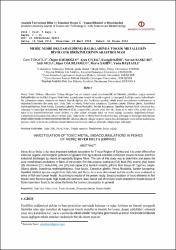Meriç Nehri Deltası (Edirne) Balıklarında Toksik Metallerin Biyolojik Birikimlerinin Araştırılması

View/
Access
info:eu-repo/semantics/openAccessDate
2016Author
Tokatlı, CemEmiroğlu, Özgür
Çiçek, Arzu
Köse, Esengül
Başkurt, Sercan
Aksu, Sadi
Baştatlı, Yasin
Metadata
Show full item recordAbstract
Meriç Nehri Deltası, ülkemizin Trakya Bölgesi'nin en önemli sucul ekosistemidir ve havzada yürütülen yoğun tarımsal faaliyetlerden ve özellikle Ergene Nehri'nden kaynaklanan önemli derecede organik ve inorganik kirliliğe maruz kalmaktadır. Bu çalışmanın amacı, sistemin en önemli biyotik öğeleri olan balıkların içerdiği toksik metal seviyelerinin belirlenmesi ve değerlendirilmesidir Bu amaç için, Gala Gölü ve Meriç Nehri'nden yakalanan Cyprinus carpio, Silurus glanis, Scardinius erythrophthalmus, Esox lucius, Carassius gibelio, Perca fluviatilis, Sander lucioperca, Squalius orpheus balık türlerinin kas, solungaç ve karaciğer dokularında kadmiyum (Cd), kurşun (Pb), arsenic (As), bor (B), krom (Cr), nikel (Ni), çinko (Zn) ve bakır (Cu) biyobirikimlerinin tespit edilmiş ve elde edilen sonuçlar balık ve insan sağlığı açısından değerlendirilmiştir. Çalışmamız sonucunda elde edilen verilere göre, Gala Gölü ve Meriç Nehri balıklarının kas, solungaç ve karaciğer dokularında tespit edilen toksik element biyobirikimlerinin oldukça yüksek olduğu ve genel olarak kas dokularında tespit edilen kadmiyum, kurşun, nikel ve krom seviyelerinin insani tüketim sınırlarının oldukça üzerinde olduğu tespit edilmiştir. Meriç River Delta is the most important wetland ecosystem for Thrace Region of Turkey and it is under effect of an intensive organic and inorganic pollution originated from agricultural activities conducted around its basin and from industrial discharges by means of especially Ergene River. The aim of this study was to determine and assess the toxic metal bioaccumulations in fishes of the system. For this purpose, cadmium (Cd), lead (Pb), arsenic (As), boron (B), chromium (Cr), nickel (Ni), zinc (Zn) and copper (Cu) levels in muscle, gill and liver tissues of Cyprinus carpio, Silurus glanis, Scardinius erythrophthalmus, Esox lucius, Carassius gibelio, Perca fluviatilis, Sander lucioperca, Squalius orpheus species caught from Gala lake and Meriç river were determined and the results were evaluated in terms of fish and human health. According to results of the present study, bioaccumulation of toxic elements in fish tissues were found in quite high levels and cadmium, lead, nickel and chromium levels detected in muscle tissue of fishes have been found to be above the limits for human consumption in general.
Source
Anadolu Üniversitesi Bilim ve Teknoloji Dergisi :C-Yaşam Bilimleri ve BiyoteknolojiVolume
5Issue
1URI
http://www.trdizin.gov.tr/publication/paper/detail/TWpJeU9UUTJOZz09https://hdl.handle.net/11421/12112

















